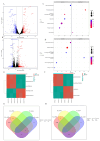Production, Passaging Stability, and Histological Analysis of Madin-Darby Canine Kidney Cells Cultured in a Low-Serum Medium
- PMID: 39340023
- PMCID: PMC11435615
- DOI: 10.3390/vaccines12090991
Production, Passaging Stability, and Histological Analysis of Madin-Darby Canine Kidney Cells Cultured in a Low-Serum Medium
Abstract
Madin-Darby canine kidney (MDCK) cells are commonly used to produce cell-based influenza vaccines. However, the role of the low-serum medium on the proliferation of MDCK cells and the propagation of the influenza virus has not been well studied. In the present study, we used 5 of 15 culture methods with different concentrations of a mixed medium and neonatal bovine serum (NBS) to determine the best culture medium. We found that a VP:M199 ratio of 1:2 (3% NBS) was suitable for culturing MDCK cells. Furthermore, the stable growth of MDCK cells and the production of the influenza virus were evaluated over long-term passaging. We found no significant difference in terms of cell growth and virus production between high and low passages of MDCK cells under low-serum culture conditions, regardless of influenza virus infection. Lastly, we performed a comparison of the transcriptomics and proteomics of MDCK cells cultured in VP:M199 = 1:2 (3% NBS) with those cultured in VP:M199 = 1:2 (5% NBS) before and after influenza virus infection. The transcriptome analysis showed that differentially expressed genes were predominantly enriched in the metabolic pathway and MAPK signaling pathway, indicating an activated state. This suggests that decreasing the concentration of serum in the medium from 5% to 3% may increase the metabolic activity of cells. Proteomics analysis showed that only a small number of differentially expressed proteins could not be enriched for analysis, indicating minimal difference in the protein levels of MDCK cells when the serum concentration in the medium was decreased from 5% to 3%. Altogether, our findings suggest that the screening and application of a low-serum medium provide a background for the development and optimization of cell-based influenza vaccines.
Keywords: MDCK cells; RNA sequencing; flu vaccine; low-serum medium; proteomics.
Conflict of interest statement
Author Ming Cai was employed by the Wuhan Institute of Biological Products Co. Ltd. The remaining authors declare that the research was conducted in the absence of any commercial or financial relationships that could be construed as a potential conflict of interest.
Figures






Similar articles
-
Madin-Darby canine kidney cell sialic acid receptor modulation induced by culture medium conditions: Implications for the isolation of influenza A virus.Influenza Other Respir Viruses. 2019 Nov;13(6):593-602. doi: 10.1111/irv.12671. Epub 2019 Aug 7. Influenza Other Respir Viruses. 2019. PMID: 31392833 Free PMC article.
-
High yield production of influenza virus in Madin Darby canine kidney (MDCK) cells with stable knockdown of IRF7.PLoS One. 2013;8(3):e59892. doi: 10.1371/journal.pone.0059892. Epub 2013 Mar 26. PLoS One. 2013. PMID: 23555825 Free PMC article.
-
[Adherent and single-cell suspension culture of Madin-Darby canine kidney cells in serum-free medium].Sheng Wu Gong Cheng Xue Bao. 2011 Apr;27(4):645-52. Sheng Wu Gong Cheng Xue Bao. 2011. PMID: 21848001 Chinese.
-
Comparison of influenza virus yields and apoptosis-induction in an adherent and a suspension MDCK cell line.Vaccine. 2013 Nov 19;31(48):5693-9. doi: 10.1016/j.vaccine.2013.09.051. Epub 2013 Oct 8. Vaccine. 2013. PMID: 24113260
-
Serum-Free Suspension Culture of MDCK Cells for Production of Influenza H1N1 Vaccines.PLoS One. 2015 Nov 5;10(11):e0141686. doi: 10.1371/journal.pone.0141686. eCollection 2015. PLoS One. 2015. PMID: 26540170 Free PMC article.
References
-
- Barr I.G., Donis R.O., Katz J.M., McCauley J.W., Odagiri T., Trusheim H., Tsai T.F., Wentworth D.E. Cell culture-derived influenza vaccines in the severe 2017–2018 epidemic season: A step towards improved influenza vaccine effectiveness. NPJ Vaccines. 2018;3:44. doi: 10.1038/s41541-018-0079-z. - DOI - PMC - PubMed
-
- Rodrigues A.F., Fernandes P., Laske T., Castro R., Alves P.M., Genzel Y., Coroadinha A.S. Cell Bank Origin of MDCK Parental Cells Shapes Adaptation to Serum-Free Suspension Culture and Canine Adenoviral Vector Production. Int. J. Mol. Sci. 2020;21:6111. doi: 10.3390/ijms21176111. - DOI - PMC - PubMed
Grants and funding
LinkOut - more resources
Full Text Sources
Research Materials
Miscellaneous

